

Compact Muon Solenoid
LHC, CERN
| CMS-SUS-17-008 ; CERN-EP-2018-297 | ||
| Search for resonant production of second-generation sleptons with same-sign dimuon events in proton-proton collisions at $\sqrt{s} = $ 13 TeV | ||
| CMS Collaboration | ||
| 24 November 2018 | ||
| Eur. Phys. J. C 79 (2019) 305 | ||
| Abstract: A search is presented for resonant production of second-generation sleptons (${\tilde{\mu}_{\mathrm{L}}} $, $\tilde{\nu}_{\mu}$) via the $R$-parity-violating coupling ${{\lambda^{\prime}_{211}}}$ to quarks, in events with two same-sign muons and at least two jets in the final state. The smuon (muon sneutrino) is expected to decay into a muon and a neutralino (chargino), which will then decay into a second muon and at least two jets. The analysis is based on the 2016 data set of proton-proton collisions at $\sqrt{s} = $ 13 TeV recorded with the CMS detector at the LHC, corresponding to an integrated luminosity of 35.9 fb$^{-1}$. No significant deviation is observed with respect to standard model expectations. Upper limits on cross sections, ranging from 0.00024 to 4.8 pb, are derived in the context of two simplified models representing the dominant signal contributions leading to a same-sign muon pair. The cross section limits are translated into coupling limits for a modified constrained minimal supersymmetric model with ${{\lambda^{\prime}_{211}}}$ as the only nonzero $R$-parity violating coupling. The results significantly extend restrictions of the parameter space compared with previous searches for similar models. | ||
| Links: e-print arXiv:1811.09760 [hep-ex] (PDF) ; CDS record ; inSPIRE record ; CADI line (restricted) ; | ||
| Additional information on efficiencies needed for reinterpretation of these results are available here. Additional technical material for CMS speakers can be found here. |
| Figures | |

png pdf |
Figure 1:
Signal contributions from a modified cMSSM with ${{\lambda ^{\prime}_{211}}}$ as an additional coupling, which are considered as simplified signal models SM1 (left) and SM2 (right) in this search. The charge conjugate diagrams are included as well. |

png pdf |
Figure 1-a:
Signal contribution from a modified cMSSM with ${{\lambda ^{\prime}_{211}}}$ as an additional coupling, which is considered as simplified signal model SM1 in this search. |
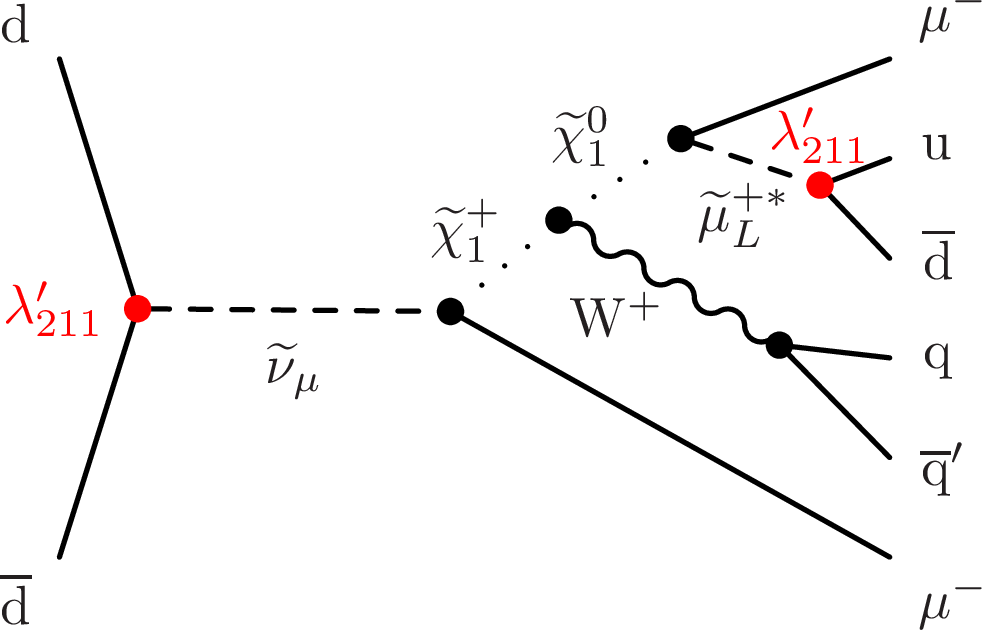
png pdf |
Figure 1-b:
Signal contribution from a modified cMSSM with ${{\lambda ^{\prime}_{211}}}$ as an additional coupling, which is considered as simplified signal model SM2 in this search. |

png pdf |
Figure 2:
Expected (after fit) and observed event yields in the SR bins as defined in Table 2. The gray band shows the systematic uncertainty in the background yields. Also shown are the expected yields for two signal points normalized to their expected limit on the cross section. The vertical bars denote the Poisson confidence intervals calculated with the Garwood procedure, while the horizontal bars show the bin width. |

png pdf |
Figure 3:
Expected (after fit) and observed event yields in the $ {m(\mu _{1}\mu _{2}+\text {jets})} $ and $ {m(\mu _{2}\text {j}_{1}\text {j}_{2})} $ distribution. Here, $ {m(\mu _{1}\mu _{2}+\text {jets})} $ is defined as the invariant mass of both muons and all jets in the event, and $ {m(\mu _{2}\text {j}_{1}\text {j}_{2})} $ is the invariant mass of the subleading muon and the two leading jets. Also shown are the expected yields for two signal points normalized to their expected limit on the cross section. The vertical bars denote the Poisson confidence intervals calculated with the Garwood procedure, while the horizontal bars show the bin width. |
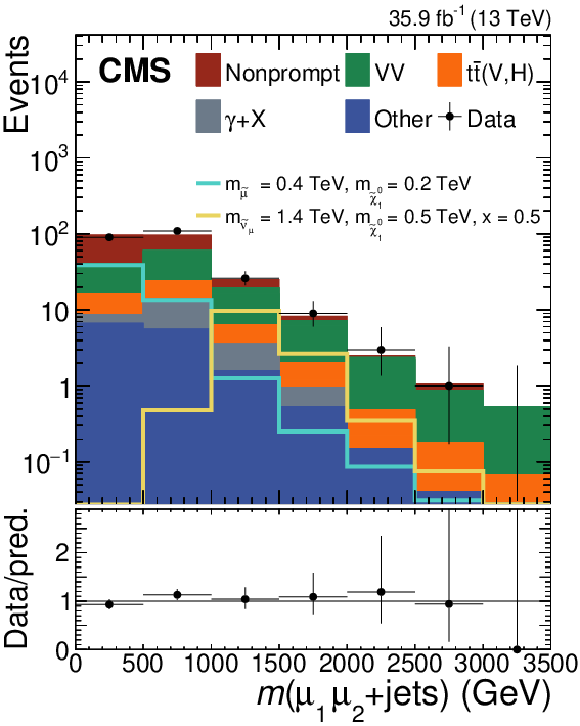
png pdf |
Figure 3-a:
Expected (after fit) and observed event yields in the $ {m(\mu _{1}\mu _{2}+\text {jets})} $ and $ {m(\mu _{2}\text {j}_{1}\text {j}_{2})} $ distribution. Here, $ {m(\mu _{1}\mu _{2}+\text {jets})} $ is defined as the invariant mass of both muons and all jets in the event. Also shown are the expected yields for two signal points normalized to their expected limit on the cross section. The vertical bars denote the Poisson confidence intervals calculated with the Garwood procedure, while the horizontal bars show the bin width. |

png pdf |
Figure 3-b:
Expected (after fit) and observed event yields in the $ {m(\mu _{1}\mu _{2}+\text {jets})} $ and $ {m(\mu _{2}\text {j}_{1}\text {j}_{2})} $ distribution. Here, $ {m(\mu _{2}\text {j}_{1}\text {j}_{2})} $ is the invariant mass of the subleading muon and the two leading jets. Also shown are the expected yields for two signal points normalized to their expected limit on the cross section. The vertical bars denote the Poisson confidence intervals calculated with the Garwood procedure, while the horizontal bars show the bin width. |

png pdf |
Figure 4:
Observed upper limits on cross sections at 95% CL. The upper left plot shows the limit in the $ {m_{\tilde{\chi}^{0}_{1}}} $ and $ {m_{{\tilde{\mu}}}} $ mass plane for SM1, while the other three plots show the SM2 limits as a function of $ {m_{\tilde{\chi}^{0}_{1}}} $ and $ {m_{{\tilde{\nu}_{\mu}}}} $ for the three different scenarios with $x = $ 0.1 (upper right), $x=$ 0.5 (lower left) and $x=$ 0.9 (lower right). The limit for a specific mass combination is depicted according to the color scale on the right-hand side of the figures. |
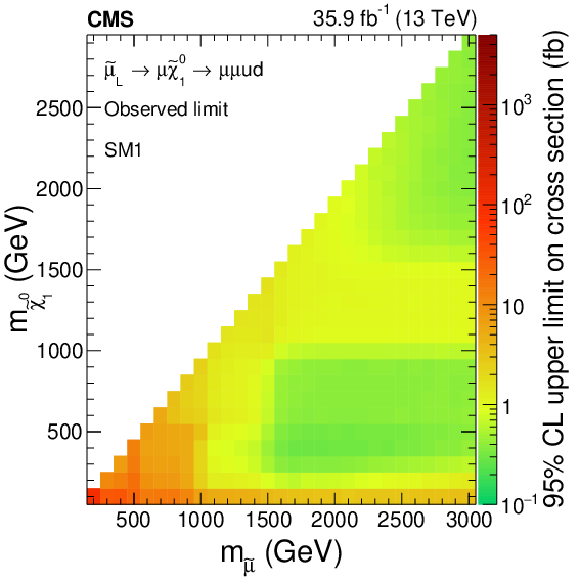
png pdf |
Figure 4-a:
Observed upper limits on cross sections at 95% CL. The plot shows the limit in the $ {m_{\tilde{\chi}^{0}_{1}}} $ and $ {m_{{\tilde{\mu}}}} $ mass plane for SM1. The limit for a specific mass combination is depicted according to the color scale on the right-hand side of the figures. |
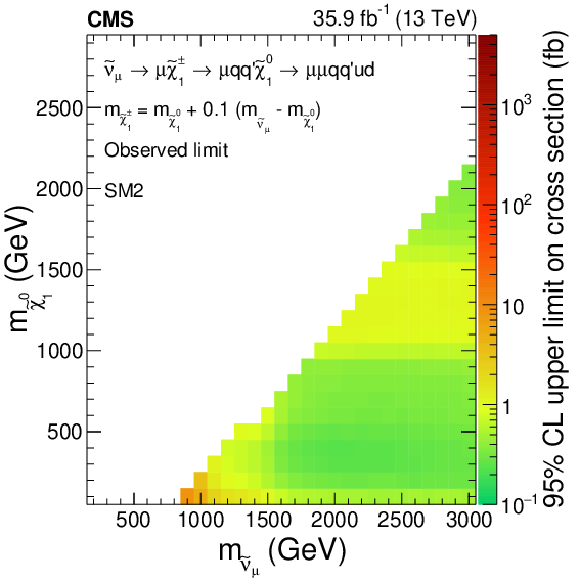
png pdf |
Figure 4-b:
Observed upper limits on cross sections at 95% CL. The plot shows the SM2 limit as a function of $ {m_{\tilde{\chi}^{0}_{1}}} $ and $ {m_{{\tilde{\nu}_{\mu}}}} $ for the scenario with $x = $ 0.1. The limit for a specific mass combination is depicted according to the color scale on the right-hand side of the figures. |

png pdf |
Figure 4-c:
Observed upper limits on cross sections at 95% CL. The plot shows the SM2 limit as a function of $ {m_{\tilde{\chi}^{0}_{1}}} $ and $ {m_{{\tilde{\nu}_{\mu}}}} $ for the scenario with $x = $ 0.5. The limit for a specific mass combination is depicted according to the color scale on the right-hand side of the figures. |

png pdf |
Figure 4-d:
Observed upper limits on cross sections at 95% CL. The plot shows the SM2 limits as a function of $ {m_{\tilde{\chi}^{0}_{1}}} $ and $ {m_{{\tilde{\nu}_{\mu}}}} $ for the scenario with $x = $ 0.9. The limit for a specific mass combination is depicted according to the color scale on the right-hand side of the figures. |

png pdf |
Figure 5:
Upper limits at 95% CL on the coupling ${{\lambda ^{\prime}_{211}}}$ as a function of ${m_{0}}$ and ${m_{1/2}}$ for a modified cMSSM with ${{\lambda ^{\prime}_{211}}}$ as additional RPV coupling. The color scale at the right side of the figure indicates the coupling limit value for specific parameter combinations. These limits are derived from the upper cross section limits of SM1. For four values of ${{\lambda ^{\prime}_{211}}}$ (0.004, 0.01, 0.02, 0.03), the coupling limits are shown as black contour lines. The dashed lines show the parameters in the model that correspond to the mass of the lightest Higgs boson for three chosen values (124, 125, 126 GeV). |
| Tables | |
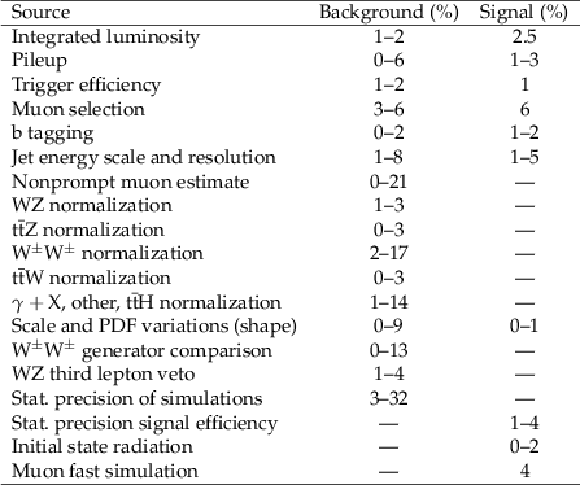
png pdf |
Table 1:
Sources of systematic uncertainties considered in this search and the range of yield variations in the signal regions. The background uncertainties are given as fractions of the total background yields in the signal regions. For the signal, the ranges covering the most relevant signal regions for each signal are given. The first three blocks affect the background predictions and list all experimental uncertainties, uncertainties for processes where the yield is obtained from data, and additional uncertainties for simulation-based backgrounds. In the last block, additional uncertainties for the signal prediction are shown. |

png pdf |
Table 2:
Expected and observed event yields in the signal regions. The uncertainties are the total systematic uncertainties in the expected yields. Also shown are the expected yields for two signal points normalized to the expected limits on the cross sections. |

png pdf |
Table 3:
Observed upper limits on cross sections at 95% CL for selected SM2 points. The corresponding limits on ${{\lambda ^{\prime}_{211}}}$ for the modified cMSSM with ${{\lambda ^{\prime}_{211}}}$ as additional coupling are shown as well. |
| Summary |
| A search for resonant production of second-generation sleptons (${\tilde{\mu}_{\mathrm{L}}} $, $\tilde{\nu}_{\mu}$) using 35.9 fb$^{-1}$ of proton-proton collisions recorded in 2016 with the CMS detector has been presented. The search targets resonant slepton production via the $R$-parity violating coupling ${{\lambda^{\prime}_{211}}}$ to quarks in final states with two same-sign muons and at least two jets. No significant excess over the background expectation is observed. Upper limits on cross sections are set in the context of two simplified models covering the dominant production mechanisms in a modified constrained minimal supersymmetric model (cMSSM) with ${{\lambda^{\prime}_{211}}}$ as an additional coupling. These limits, ranging from 0.00024 to 4.8 pb, are translated into limits on the coupling ${{\lambda^{\prime}_{211}}}$ in the modified cMSSM, and represent the most stringent limits on this particular model of $R$-parity violating supersymmetry. |
| References | ||||
| 1 | P. Ramond | Dual theory for free fermions | PRD 3 (1971) 2415 | |
| 2 | Y. A. Gol'fand and E. P. Likhtman | Extension of the algebra of Poincar$ \'e $ group generators and violation of P invariance | JEPTL 13 (1971)323 | |
| 3 | A. Neveu and J. H. Schwarz | Factorizable dual model of pions | NPB 31 (1971) 86 | |
| 4 | D. V. Volkov and V. P. Akulov | Possible universal neutrino interaction | JEPTL 16 (1972)438 | |
| 5 | J. Wess and B. Zumino | A Lagrangian model invariant under supergauge transformations | PLB 49 (1974) 52 | |
| 6 | J. Wess and B. Zumino | Supergauge transformations in four-dimensions | NPB 70 (1974) 39 | |
| 7 | P. Fayet | Supergauge invariant extension of the Higgs mechanism and a model for the electron and its neutrino | NPB 90 (1975) 104 | |
| 8 | G. R. Farrar and P. Fayet | Phenomenology of the production, decay, and detection of new hadronic states associated with supersymmetry | PLB 76 (1978) 575 | |
| 9 | A. J. Buras, J. Ellis, M. K. Gaillard, and D. V. Nanopoulos | Aspects of the grand unification of strong, weak and electromagnetic interactions | NPB 135 (1978) 66 | |
| 10 | S. Weinberg | Supersymmetry at ordinary energies. Masses and conservation laws | PRD 26 (1982) 287 | |
| 11 | H. P. Nilles | Supersymmetry, supergravity and particle physics | PR 110 (1984) 1 | |
| 12 | H. E. Haber and G. L. Kane | The search for supersymmetry: Probing physics beyond the standard model | PR 117 (1985) 75 | |
| 13 | S. P. Martin | A supersymmetry primer | Adv. Ser. Direct. High Energy Phys. 21 (2010) 1 | hep-ph/9709356 |
| 14 | L. E. Ib\'a\ nez and G. Ross | Discrete gauge symmetries and the origin of baryon and lepton number conservation in supersymmetric versions of the standard model | NPB 368 (1992) 3 | |
| 15 | H. K. Dreiner, C. Luhn, and M. Thormeier | What is the discrete gauge symmetry of the MSSM? | PRD 73 (2006) 075007 | hep-ph/0512163 |
| 16 | R. Barbier et al. | $ R $-parity violating supersymmetry | PR 420 (2005) 1 | hep-ph/0406039 |
| 17 | S. Dimopoulos and L. J. Hall | Lepton- and baryon-number violating collider signatures from supersymmetry | PLB 207 (1988) 210 | |
| 18 | S. Dimopoulos et al. | Cross sections for lepton- and baryon-number-violating processes from supersymmetry at $ p\bar{p} $ colliders | PRD 41 (1990) 2099 | |
| 19 | H. Dreiner and G. G. Ross | $ R $-parity violation at hadron colliders | NPB 365 (1991) 597 | |
| 20 | H. K. Dreiner, P. Richardson, and M. Seymour | Resonant slepton production in hadron-hadron collisions | PRD 63 (2001) 055008 | hep-ph/0007228 |
| 21 | F. D\'eliot, G. Moreau, and C. Royon | Single superpartner production at Tevatron Run II | EPJC 19 (2001) 155 | hep-ph/0007288 |
| 22 | H. K. Dreiner, S. Grab, M. Kramer, and M. K. Trenkel | Supersymmetric NLO QCD corrections to resonant slepton production and signals at the Fermilab Tevatron and the CERN LHC | PRD 75 (2007) 035003 | hep-ph/0611195 |
| 23 | C. Kilic and S. Thomas | Signatures of resonant superpartner production with charged-current decays | PRD 84 (2011) 055012 | 1104.1002 |
| 24 | B. C. Allanach, S. Biswas, S. Mondal, and M. Mitra | Resonant slepton production yields CMS $ {\mathrm{e}}{\mathrm{e}} $jj and $ {\mathrm{e}}{p_{\mathrm{T}}} $jj excesses | PRD 91 (2015) 015011 | 1410.5947 |
| 25 | B. C. Allanach, P. S. B. Dev, S. A. Renner, and K. Sakurai | 750 GeV diphoton excess explained by a resonant sneutrino in $ R $-parity violating supersymmetry | PRD 93 (2016) 115022 | 1512.07645 |
| 26 | D0 Collaboration | Search for resonant second generation slepton production at the Tevatron | PRL 97 (2006) 111801 | hep-ex/0605010 |
| 27 | H. K. Dreiner and T. Stefaniak | Bounds on $ R $-parity violation from resonant slepton production at the LHC | PRD 86 (2012) 055010 | 1201.5014 |
| 28 | CMS Collaboration | Search for supersymmetric partners of electrons and muons in proton-proton collisions at $ \sqrt{s}= $ 13 TeV | Submitted to PLB | CMS-SUS-17-009 1806.05264 |
| 29 | ATLAS Collaboration | Search for electroweak production of supersymmetric particles in final states with two or three leptons at $ \sqrt{s}= $ 13 TeV with the ATLAS detector | Submitted to EPJC | 1803.02762 |
| 30 | ATLAS Collaboration | Search for supersymmetry in final states with two same-sign or three leptons and jets using 36 fb$ ^{-1} $ of $ \sqrt{s}= $ 13 TeV pp collision data with the ATLAS detector | JHEP 09 (2017) 084 | 1706.03731 |
| 31 | CMS Collaboration | Search for physics beyond the standard model in events with two leptons of same sign, missing transverse momentum, and jets in proton-proton collisions at $ \sqrt{s}= $ 13 TeV | EPJC 77 (2017) 578 | CMS-SUS-16-035 1704.07323 |
| 32 | D. Dercks et al. | $ R $-parity violation at the LHC | EPJC 77 (2017) 856 | 1706.09418 |
| 33 | G. L. Kane, C. Kolda, L. Roszkowski, and J. D. Wells | Study of constrained minimal supersymmetry | PRD 49 (1994) 6173 | hep-ph/9312272 |
| 34 | D. Alves et al. | Simplified models for LHC new physics searches | JPG 39 (2012) 105005 | 1105.2838 |
| 35 | CMS Collaboration | Interpretation of searches for supersymmetry with simplified models | PRD 88 (2013) 052017 | CMS-SUS-11-016 1301.2175 |
| 36 | CMS Collaboration | The CMS experiment at the CERN LHC | JINST 3 (2008) S08004 | CMS-00-001 |
| 37 | CMS Collaboration | The CMS trigger system | JINST 12 (2017) P01020 | CMS-TRG-12-001 1609.02366 |
| 38 | CMS Collaboration | Particle-flow reconstruction and global event description with the CMS detector | JINST 12 (2017) P10003 | CMS-PRF-14-001 1706.04965 |
| 39 | M. Cacciari, G. P. Salam, and G. Soyez | The anti-$ {k_{\mathrm{T}}} $ jet clustering algorithm | JHEP 04 (2008) 063 | 0802.1189 |
| 40 | M. Cacciari, G. P. Salam, and G. Soyez | FastJet user manual | EPJC 72 (2012) 1896 | 1111.6097 |
| 41 | CMS Collaboration | Jet energy scale and resolution in the CMS experiment in pp collisions at 8 TeV | JINST 12 (2017) P02014 | CMS-JME-13-004 1607.03663 |
| 42 | CMS Collaboration | Identification of heavy-flavour jets with the CMS detector in pp collisions at 13 TeV | JINST 13 (2018) P05011 | CMS-BTV-16-002 1712.07158 |
| 43 | CMS Collaboration | Performance of the CMS muon detector and muon reconstruction with proton-proton collisions at $ \sqrt{s}= $ 13 TeV | JINST 13 (2018) P06015 | CMS-MUO-16-001 1804.04528 |
| 44 | J. Alwall et al. | The automated computation of tree-level and next-to-leading order differential cross sections, and their matching to parton shower simulations | JHEP 07 (2014) 079 | 1405.0301 |
| 45 | J. Alwall et al. | Comparative study of various algorithms for the merging of parton showers and matrix elements in hadronic collisions | EPJC 53 (2008) 473 | 0706.2569 |
| 46 | J. Alwall, S. de Visscher, and F. Maltoni | QCD radiation in the production of heavy colored particles at the LHC | JHEP 02 (2009) 017 | 0810.5350 |
| 47 | A. Kalogeropoulos and J. Alwall | The SysCalc code: A tool to derive theoretical systematic uncertainties | 1801.08401 | |
| 48 | R. Frederix and S. Frixione | Merging meets matching in MC@NLO | JHEP 12 (2012) 061 | 1209.6215 |
| 49 | P. Nason | A new method for combining NLO QCD with shower Monte Carlo algorithms | JHEP 11 (2004) 040 | hep-ph/0409146 |
| 50 | S. Frixione, P. Nason, and C. Oleari | Matching NLO QCD computations with parton shower simulations: the POWHEG method | JHEP 11 (2007) 070 | 0709.2092 |
| 51 | S. Alioli, P. Nason, C. Oleari, and E. Re | A general framework for implementing NLO calculations in shower Monte Carlo programs: the POWHEG BOX | JHEP 06 (2010) 043 | 1002.2581 |
| 52 | T. Melia, P. Nason, R. Rontsch, and G. Zanderighi | $ \mathrm{W}^+ \mathrm{W}^- $, $ \mathrm{W} \mathrm{Z} $ and $ \mathrm{Z} \mathrm{Z} $ production in the POWHEG BOX | JHEP 11 (2011) 078 | 1107.5051 |
| 53 | P. Nason and G. Zanderighi | $ \mathrm{W}^+ \mathrm{W}^- $, $ \mathrm{W} \mathrm{Z} $ and $ \mathrm{Z} \mathrm{Z} $ production in the POWHEG-BOX-V2 | EPJC 74 (2014) 2702 | 1311.1365 |
| 54 | H. B. Hartanto, B. Jager, L. Reina, and D. Wackeroth | Higgs boson production in association with top quarks in the POWHEG BOX | PRD 91 (2015) 094003 | 1501.04498 |
| 55 | E. Bagnaschi, G. Degrassi, P. Slavich, and A. Vicini | Higgs production via gluon fusion in the POWHEG approach in the SM and in the MSSM | JHEP 02 (2012) 088 | 1111.2854 |
| 56 | T. Sjostrand, S. Mrenna, and P. Z. Skands | A brief introduction to PYTHIA 8.1 | CPC 178 (2008) 852 | 0710.3820 |
| 57 | P. Skands, S. Carrazza, and J. Rojo | Tuning PYTHIA 8.1: the Monash 2013 tune | EPJC 74 (2014) 3024 | 1404.5630 |
| 58 | CMS Collaboration | Event generator tunes obtained from underlying event and multiparton scattering measurements | EPJC 76 (2016) 155 | CMS-GEN-14-001 1512.00815 |
| 59 | NNPDF Collaboration | Parton distributions for the LHC Run II | JHEP 04 (2015) 040 | 1410.8849 |
| 60 | GEANT4 Collaboration | GEANT4--a simulation toolkit | NIMA 506 (2003) 250 | |
| 61 | S. Abdullin et al. | The fast simulation of the CMS detector at LHC | J. Phys. Conf. Ser. 331 (2011) 032049 | |
| 62 | F. Staub | SARAH 4: A tool for (not only SUSY) model builders | CPC 185 (2014) 1773 | 1309.7223 |
| 63 | F. Staub, T. Ohl, W. Porod, and C. Speckner | A tool box for implementing supersymmetric models | CPC 183 (2012) 2165 | 1109.5147 |
| 64 | M. D. Goodsell, K. Nickel, and F. Staub | Two-loop Higgs mass calculations in supersymmetric models beyond the MSSM with SARAH and SPheno | EPJC 75 (2015) 32 | 1411.0675 |
| 65 | M. D. Goodsell and F. Staub | The Higgs mass in the CP violating MSSM, NMSSM, and beyond | EPJC 77 (2017) 46 | 1604.05335 |
| 66 | F. Staub and W. Porod | Improved predictions for intermediate and heavy supersymmetry in the MSSM and beyond | EPJC 77 (2017) 338 | 1703.03267 |
| 67 | W. Porod | SPheno, a program for calculating supersymmetric spectra, SUSY particle decays and SUSY particle production at $ {\mathrm{e}}^{+}{\mathrm{e}}^{-} $ colliders | CPC 153 (2003) 275 | hep-ph/0301101 |
| 68 | W. Porod and F. Staub | SPheno 3.1: Extensions including flavour, CP-phases and models beyond the MSSM | CPC 183 (2012) 2458 | 1104.1573 |
| 69 | CMS Collaboration | Search for new physics in same-sign dilepton events in proton-proton collisions at $ \sqrt{s}= $ 13 TeV | EPJC 76 (2016) 439 | CMS-SUS-15-008 1605.03171 |
| 70 | CMS Collaboration | Performance of the CMS missing transverse momentum reconstruction in pp data at $ \sqrt{s} = $ 8 TeV | JINST 10 (2015) P02006 | CMS-JME-13-003 1411.0511 |
| 71 | CMS Collaboration | Reconstruction and identification of $ \tau $ lepton decays to hadrons and $ \nu_\tau $ at CMS | JINST 11 (2016) P01019 | CMS-TAU-14-001 1510.07488 |
| 72 | CMS Collaboration | CMS luminosity measurements for the 2016 data taking period | CMS-PAS-LUM-17-001 | CMS-PAS-LUM-17-001 |
| 73 | M. Cacciari et al. | The $ \mathrm{t\bar{t}} $ cross-section at 1.8~TeV and 1.96~TeV: A study of the systematics due to parton densities and scale dependence | JHEP 04 (2004) 068 | hep-ph/0303085 |
| 74 | S. Catani, D. de Florian, M. Grazzini, and P. Nason | Soft gluon resummation for Higgs boson production at hadron colliders | JHEP 07 (2003) 028 | hep-ph/0306211 |
| 75 | R. D. Cousins, K. E. Hymes, and J. Tucker | Frequentist evaluation of intervals estimated for a binomial parameter and for the ratio of Poisson means | NIMA 612 (2010) 388 | 0905.3831 |
| 76 | CMS Collaboration | Search for top-squark pair production in the single-lepton final state in pp collisions at $ \sqrt{s} = $ 8 TeV | EPJC 73 (2013) 2677 | CMS-SUS-13-011 1308.1586 |
| 77 | T. Junk | Confidence level computation for combining searches with small statistics | NIMA 434 (1999) 435 | hep-ex/9902006 |
| 78 | A. L. Read | Presentation of search results: The CL$ _\text{s} $ technique | JPG 28 (2002) 2693 | |
| 79 | ATLAS and CMS Collaborations, and LHC Higgs Combination Group | Procedure for the LHC Higgs boson search combination in Summer 2011 | CMS-NOTE-2011-005 | |
| 80 | G. Cowan, K. Cranmer, E. Gross, and O. Vitells | Asymptotic formulae for likelihood-based tests of new physics | EPJC 71 (2011) 1554 | 1007.1727 |

|
Compact Muon Solenoid LHC, CERN |

|

|

|

|

|

|